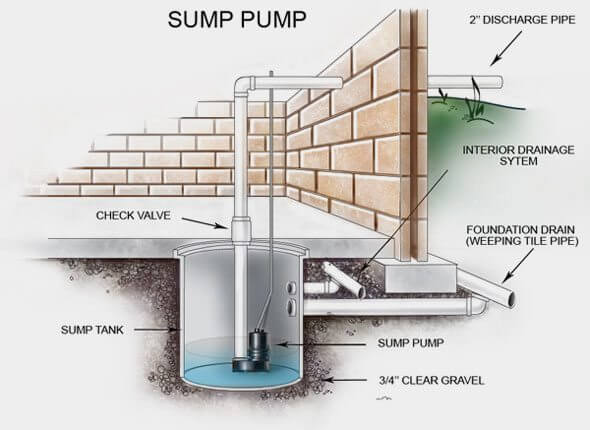Investing in a home is a lifetime decision; therefore the safety of a home is a super important consideration. Often houses are constructed in flood prone areas, or with high groundwater. In fact according to the American Society of Home Inspectors, more than 60 percent of American homes suffer from below-ground wetness [source: Home Inspector]. It doesn’t take much water to cause thousands of dollars of damage, and health hazards from mold, and mildew.
Sump pumps are small pumps installed in the lowest part of a basement or crawlspace. Its job is to help keep the area under the building dry and to prevent it from flooding. Usually, sump pumps are installed in specially constructed sump pits. Water flows into the sump pit through drains or by natural water migration through the soil. The sump pump’s job is to pump the water out of the pit and away from the building so the basement or crawlspace stays dry.
Sump pumps can clear the settled water in the basement after heavy rains, snow, and after flooding situations. In floods and bad weather situations electricity power outages are normal. Which is why some sump pumps have a battery backup to prevent failure. In flood prone areas sump pumps are as essential as any other household item.
Mold and mildew can quickly occur after so water needs to be flushed out as soon as possible. In addition to functional usefulness sump pumps do not deface the interior of your home, because they can easily be concealed.
Sump pumps can be used during heavy rains and many types are available on the market with single pump, double pump and even with three pumps options. How well a sump pump works depends upon the size of area needing to be covered and how often that area is prone to floods and/or precipitation. Sump pumps with double and three pumps provide back up in case of failure of pump. Sump pumps should be serviced regularly to prevent failure. But, do sump pumps prevent flooding?
Despite the usefulness of sump pumps in emergency situations they also have some shortcomings, they do require electricity, and just like any machine can fail even ones with battery backups. Leaving you high, and not dry. There can be some bad smells related to water sitting in the sump pump. It also can be an opening in your basement that can allow hazardous radon into your home.
The Sani-Tred Alternative
The Sani-Tred system has been trusted by over 100,000 do it yourselfers and contractors to permanently waterproof basements and more. Sani-Tred permanently bonds with concrete forming a shield against water permanently eliminating the need for sump pumps and other destructive forms of mitigating water in basements. Don’t take our word for it read what one customer had to say:
“I’m happy to say that I have no sump pumps running right now. That’s saying a lot when you consider that this time last year I had 6 pumps running, with 4 that never ever shut off.
Our property suffers from a seasonally perched water table. Needless to say, it was a complete surprise our first winter when 3 x 1/2 HP 2″ discharge pumps weren’t enough to keep the water out. We had a second pit dug and added more pumps but it still wasn’t enough in the spring (and we had 2000′ of 6″ tile on our property!).
I’m now patched and completely happy. No pumps even after a 3″ rain and a 2 foot snow melt! Now we just need to get the insurance companies to recognize how much money this is going to save them in order to lower my rates” – J. Kennedy
To find out more about how we can help you with your basement call our experts at 1-866-784-3308 or visit https://sanitred.com/basement-waterproofing today.



The information about how sump pumps are installed is really interesting. I’ve always wondered why they’re installed in pits, so it’s good to know that it’s in a pit to allow water to flow through there and into the drains. Now I can see why there’s usually a strong sewage smell and puddles when a sump pump isn’t working properly. It seems like it has a vital role in making sure that it stays dry by pumping the water out of the pit.